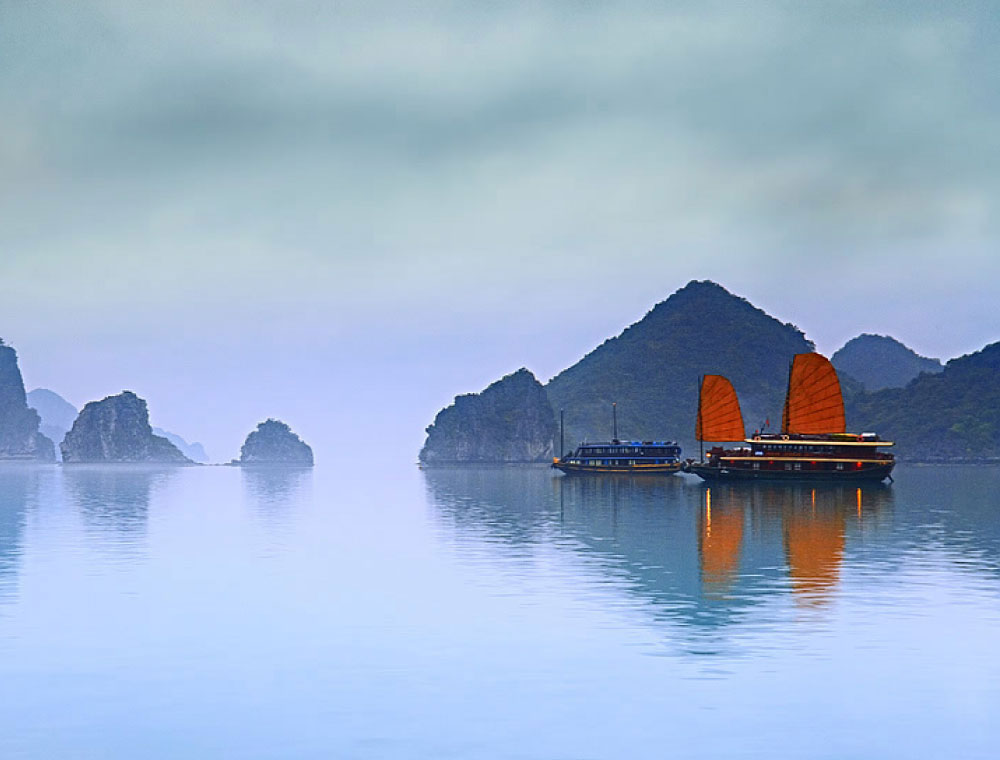THE IMPERIAL CITADEL
The construction of the Imperial Citadel, designed for exclusive use by the emperor, his family, and his retinue, started in 1804. The city is protected by a series of four enormous outer walls that are 7-21 meters thick. Access to the walled city is via four arched gates, the best known of which is the Ngo Mon Gate, built in 1834. The Imperial City contains a series of palaces, ornate halls, libraries, residences, and colleges. Much of the City, including the Forbidden Palace, was destroyed during a vicious battle between opposing forces during the Tet Offensive of 1968. One can spend an entire afternoon wandering around the grounds of the Imperial City, viewing the ancient architecture of the Nguyen emperors and scars of recent battles.
THE TOMB OF EMPEROR MINH MANG
Much of the Imperial City was built during the reign of Emperor Minh Mang. His tomb is located at the juncture of two tributaries of the Perfume River surrounded by rolling hills. It is said that it took 13 years to find an appropriate burial site for the Emperor and upon arrival it's not hard to see why this location was chosen. Set within an exquisitely landscaped garden it is a tranquil and idyllic place. The site is considered one of the best examples of Nguyen Dynasty architecture and artwork.
THE TOMB OF EMPEROR TU DUC
This tomb is located in an area of rolling hills and pine trees 7km outside Hue. The tranquil grounds are filled with trees, ponds and pavilions where Tu Duc would write poetry. Emperor Tu Duc had his tomb built 16 years prior to his death and actually wrote his own biography prior to his death.
THE TOMB OF EMPEROR KHAI DINH
Khai Dinh's was the last Mausoleum built during the Nguyen Dynasty, and is arguably the most beautiful of all the royal tombs. Situated on one of the Chau Mountains, amidst pine, cassava and sugar cane, Khai Dinh's tomb is surrounded by natural beauty. Its architecture is a blend of East and West. It took eleven years to build and was completed in 1931.
THIEN MU PAGODA
Thien Mu Pagoda is one of the oldest religious structures in Hue and is also one of the most impressive. It was constructed during the 17th century to worship the legend of a celestial lady. In 1844, Emperor Thieu Tri added the Phuoc Duyen stupa. This seven-storey stupa is 21 meters high, with each level dedicated to one of the various human forms taken by Buddha. In the 1930s and 1940s the Thien Mu Pagoda became an important meeting place for Buddhists. It became well-known worldwide when, in 1963, Thich Quang Duc, a 66 year old resident monk, died after setting himself on fire to protest anti-Buddhist policies of the government of South Vietnam. It is best to visit the pagoda by sampan as it sits on the banks of the Perfume River.
THA OM GARDEN HOUSE
The Tha Om Garden House offers an opportunity to relax and enjoy traditional Vietnamese hospitality in the surrounds of a fully-working and functioning replica of a 19th century Hue residence. The house is situated in a charming garden containing a variety of trees, plants and a lotus pond and is in fact a complex of adjoining rooms including bedrooms, living quarters and a room dedicated to ancestral worship.
THANH TOAN VlLLAGE
8km outside of Hue is a charming and undisturbed village surrounded by green rice paddies and irrigation canals. Visitors wishing to unhurriedly explore a rural and quiescent countryside should visit this village. In the middle of the village lies an aesthetically pleasing bridge made of roof tiles. Additionally, the nearby village market adorns a vivid image of Vietnam’s countryside.
LANG CO BEACH
One of Vietnam’s most accessible, pristine, yet least visited beaches. Set against a backdrop of the verdant foothills of the Annamite Cordillera, Lang Co beach lies on the eastern side of a spit between a semi-bracken lagoon and the South China Sea. It is generally overlooked by travellers in too much haste making their way north or south between Danang and Hue, and they are the poorer for their haste.
A leisurely drive up over the Hai Van Pass from Danang, Lang Co is pure beach relaxation without much of the “in your face” commercialism (Yet!) which afflicts all the better known beach destinations in Vietnam. The sands along the 8-9km stretch of beach are clean and the water is clear unless there are storms about out in the South China Sea.
There is a resort with the usual facilities on Lang Co beach and quite a few private guesthouses and hotels have opened their doors along the beachfront to welcome overseas travellers.
April to July is the best time for beach relaxation on this end of the central coast. However, August-September also heralds the beginning of the typhoon season, so some pounding surf and stormy weather can be experienced.
